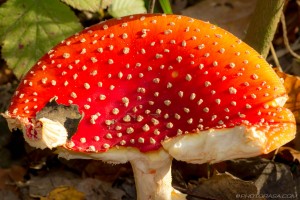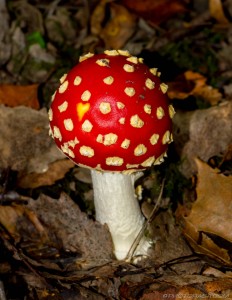Fly Agaric Red and White Mushroom
The Fly Agaric Mushroom (Amanita muscaria) is a striking fungus, known for its poisonously mind-altering psychedelic properties and strikingly colourful red dome with white spots. It is a member of the Amanita family of mushrooms, many of which are among the most poisonous known fungi in the world. The mushroom originally grew in the northern hemisphere though it has now spread throughout the world due to its spores being transferred in exported plants and trees such as birch and pine. Due to its markings the fungus is easy to identify, though it should be noted that the weather can remove or dull the red markings on older examples of the fungus, thus making it look more like a typical edible mushroom. Also, very young samples can be misidentified because they lack the red colouring and resemble little puffballs.
Fly Agaric – Origins of the Name
The “fly” moniker of the mushroom is present in its nickname in many European languages and is thought to be derived from its use as an insecticide to kill flies and other bugs. When pieces of the fungus are sprinkled a bowl of milk, and left in an open room, any flies will come to drink the milk / agaric mixture and be killed as a result. This practice has been recorded from Germanic and Slavic parts of Europe, as well as parts of France and Romania.
Trippy Psychoactives in the Fly Agaric Mushroom
The fly agaric’s mind-altering properties are due to the presence of 3 substances – muscarine, muscimol and ibotenic acid. These substances combine to agitate the brain’s neurotransmitters and cause a number of mind and body altering conditions within 2 hours of ingestion. These have been recorded to include depression, sedation, trance-like feelings, dissociative feelings and delirium. The distortion of perception is also possible with phenomena such as macropsia and micropsia known to occur, similar to the events described after mushrooms are eaten in Lewis Carroll’s Alice in Wonderland. The fly agaric is not widely used as a recreational drug due to its unpredictable qualities, though there is evidence it has been used recreationally in the past in rural areas of Europe. There is also evidence it was used in pagan times in shamanic ceremonies and rituals.
Is it poisonous?
Although often classified as deadly or highly poisonous, there have been no reported deaths from ingestion of the fly agaric in recent times, though historical records show it has happened in times before modern medicine. It’s bad reputation is more than likely due to it being a member of the amanita family of mushrooms which includes some of the most poisonous mushrooms in the world such as the death cap and the destroying angel. As a comparison, it is estimated that at least 15 medium sized fly agaric caps would have to be ingested to cause potential death whereas as little as half a cap of the destroying angel is required to cause multiple organ failure and death.
The fly agaric is actually edible if parboiled – this preparation process detoxifies – removes the harmful substances – from the mushroom and makes it suitable to eat. Though not widespread, the use of the fly agaric as a foodstuff has been recorded in North America, Russia and Japan, among other countries. Several prominent mycologists have actually called for its reclassification in mushroom guides from a poisonous to an edible mushroom. They point out that other poisonous-when-eaten-raw mushrooms such as morels are classified as edible despite needing the same preparation as fly agarics to make them edible.
More information about the Fly agaric mushroom can be found at the Kew Gardens website.





